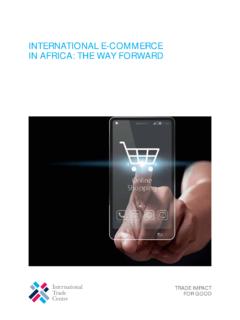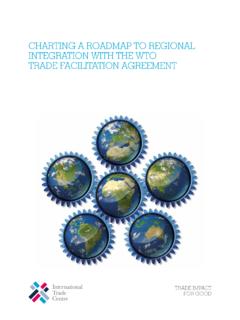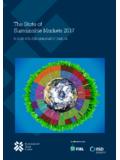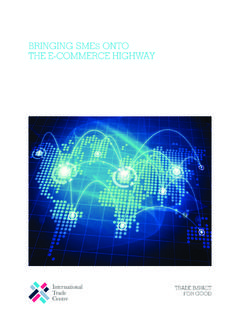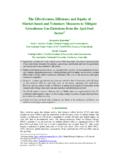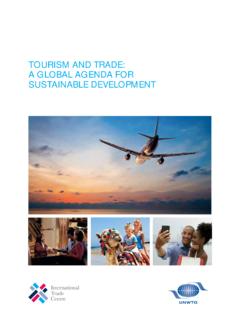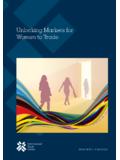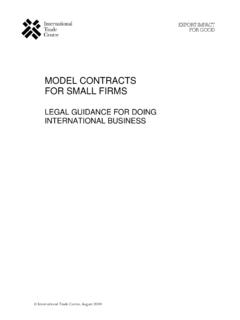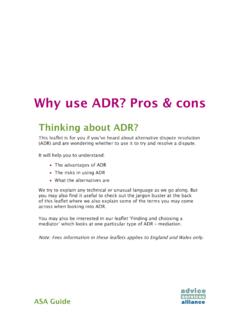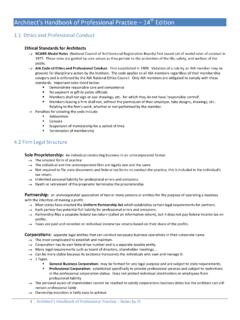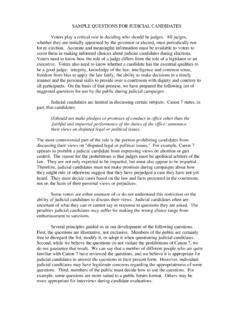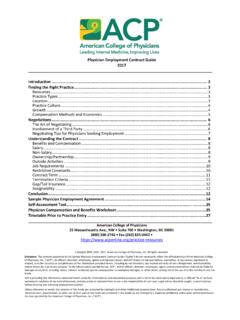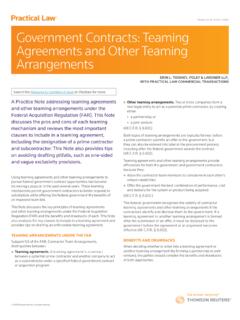Transcription of Cocoa: A guide to trade practices
1 CocoaA guide to trade practicesCocoa: A guide to trade practicesITCP roduct and market developmentProduct and market developmentInternational trade CentreProduct and market developmentInternational trade CentreCocoaA guide to trade practicesGeneva 2001iiABSTRACT FOR trade INFORMATION SERVICES2001 SITC 072 COCINTERNATIONAL trade CENTRE UNCTAD/WTO Cocoa: A guide to trade practicesGeneva: ITC, 2001. xi, 180 describing trade and industry practices , as well as regulations applying to cocoa traces customs procedures, systems and techniques used at each stage of the cocoa supply chain; reviews trends incocoa manufacturing and processing, electronic commerce, cocoa organic farming, fair trade ,sustainable production and environmental issues; also provides list of main sector-related trade andindustry associations; appendices contain detailed statistical data and list of relevant descriptors: cocoa, trade practices , statistical , French, SpanishPalais des Nations, 1211 Geneva 10, Switzerland The Government of Denmark financed the preparation and publication of this designations employed and the presentation of material in this publication do not imply theexpression of any opinion whatsoever on the part of the International trade CentreUNCTAD/WTO concerning the legal status of any country, territory, city or area or of itsauthorities, or concerning the delimitation of its frontiers or of firm names, commercial products and brand names does not imply the endorsementof ITC.
2 International trade Centre UNCTAD/WTO 2001 All rights reserved. No part of this publication may be reproduced, stored in a retrieval system or transmitted in anyform or by any means, electronic, electrostatic, magnetic tape, mechanical, photocopying or otherwise, without priorpermission in writing from the International trade 92-9137-163-7 AcknowledgementsJ. J. Scheu, former Chief Executive Officer of the Cocoa Merchants Association of America, Inc.,coordinated the preparation of this guide and wrote a large part of the text. Robin Dand, specialist incocoa logistics and author of several publications, including ITC s Cocoa: A Shipper s Manual (1990), was a collaborating author and contributed essential material. Beatriz Wagner of Wagner Enterprisesprovided detailed technical contributions were provided by Jan Vingerhoets, Alan Brewer, Navin Mistry and MaryFaherty of the International Cocoa Organization; Ted Davis of the New York Board of trade ; StevenWateridge of E D & F Man Cocoa Ltd; Louis Bensdorp, Rodger Wegner and Frans van Luijk of theNetherlands, German and French cocoa associations respectively; Cliff Neibling of Natexis, New York;and Paul Mallon of Additional assistance was gratefully received from a number of personsrepresenting cocoa trade bodies, including CAOBISCO, IOCCC, CMA, ACRI, BCCCA and ITC, Bertil Byskov, Chief, Market Development Section, and Morten Scholer, Senior MarketDevelopment Adviser, were responsible for overall management, coordination and strategic Loades edited the guide .
3 Leni Sutcliffe carried out an editorial review, and Carmelita Endayaprepared the copy for printing. Bohdan Petyhyrycz created the cover illustration. The cover itself was designed by Marilyn Langfeld. An editorial review board, consisting of the following members, reviewed and commented on a draft ofthe guide : Louis Bensdorp Managing DirectorNetherlands Cocoa Association James BoweFormer President and Chief Executive OfficerNew York Board of TradeGuy-Alain GauzeAncien Ministre de la promotion du commerce ext rieureAbidjan, C te d IvoireBernd GraapChairman German Cocoa trade Association Edouard Kouam Executive DirectorInternational Cocoa OrganizationAnthony LassHead of Agricultural and Environmental AffairsCadbury LimitedBirmingham, United KingdomFrans van LuijkD l gue g n ralF d ration du commerce des cacaosParis, FranceHarvey McGrathManaging DirectorED & F Man Group plcLondon, United KingdomPhilip SigleyChief ExecutiveCocoa Association of London LtdLondon.
4 United Kingdom ContentsAcknowledgementsiiiIntroduction1 PART ONE PRODUCTION AND SUPPLY3 CHAPTER 1 Cocoa production5 Cocoa growing5 Main factors in cocoa production5 Smallholder farming7 Weather and disease7 Sustainable production8 Main producing countries9C te d Ivoire10 Ghana10 Indonesia11 Nigeria12 Brazil12 Cameroon13 Ecuador14 Malaysia14 Box 1 Varieties of cocoa5 Box 2 Bean types6 Box 3 Cacao or cocoa ?6 Box 4 Harvest seasons8 Table 1 World production of cocoa beans, by country, by quantity and as percentage of total, 1990/91-1999/009 CHAPTER 2 Historical development of cocoa supply16 Shifts between countries in the twentieth century16 Cocoa booms and crises17 Shifts within countries18 The mechanics of the cocoa cycle18 Price cycles20 Future projections20 Figure 1 World production of cocoa in the twentieth century18 Table 2 Cocoa production, by region and by quantity, projections to 200520 CHAPTER 3 Economic importance of cocoa to producing countries 21 Social and economic impact21 Value adding through processing21 Export earnings from cocoa22C te d Ivoire23 Ghana23 Nigeria23 Cameroon24 Brazil24 Ecuador24 Malaysia24 Indonesia 25 Summary25 Table 3 Cocoa-derived exports from selected countries, by value, over five-year periods from 1971 to 199722 Table 4 Cocoa-derived export earnings.
5 Percentage share in total exports by country, 1971-199723 CHAPTER 4 Marketing methods at origin26 Free markets26 Improved access to information 27 Purchasing schemes27 pros and cons of the free market system28 CHAPTER 5 Fine or flavour cocoa29 High-quality chocolate29 Niche markets30 Box 5 Light breaking and dark breaking beans30 Table 5 Fine and flavour cocoa: annual production, by country and by quantity, 1988/89-1998/9930viPART TWOEXPORTING AND SHIPPING31 CHAPTER 6 Shipping cocoa beans33 From farm to export point33 Producing good quality34 Assessing quality35 Sampling 36 Methodology of analysis36 Supervision at departure39 Assurance of contractual performance39 Payment39 FOB sales40 Post payment 41 Weights41 Quality 41 Infestation 41 Condition 41 Marine transport41 Physical elements42 Documentary elements42 Modes of shipment42 Marine insurance44 FOB and CFR sales44 CIF sales44 Phytosanitation46 Fumigation46 Cooperation between exporter and importer49 Supervision on arrival49 CHAPTER 7 Post-harvest treatment of cocoa51 Maintaining quality51 Pest control52 Current practices52 Potential alternatives53 The need for change55 CHAPTER 8 Standard contracts57 Current standard contracts57 Two approaches58 The most important clauses59viiCHAPTER 9 The cocoa trade in importing countries61 The importer s
6 Role61An exporter s first sale62 Classifications and import duties63 Box 6 Who is who in the trade62 Box 7 Cocoa beans and products in the Harmonized System64 PART THREECOCOA TRADING65 CHAPTER 10 Characteristics of a commodity exchange67 Long history67 Physical and futures markets68 The physical market68 The futures market69 Futures commission merchants72 Cocoa options73 Hedging: the link between physical and futures markets 73 Examples of hedging operations74 Box 8 LIFFE and NYBOT71 Box 9 Daily prices of cocoa beans72 CHAPTER 11 Risk management76 Physical risks76 Performance risks (partner risks)76 Market risks78 CHAPTER 12 Regulatory aspects of cocoa trading80 Examples from the United states80 Automatic detention of imports from certain origins 80 Residue tolerances81 Unauthorized entry of animals and plants81 Jute and sisal bag specifications82 Unusual incidents82viiiCHAPTER 13 Financial aspects of cocoa trading83 Document trading giving way to added-service trading83 Working capital84 Relationships with banks84 CHAPTER 14 Arbitration86 Quality and technical arbitration86 Different uses of arbitration87 CHAPTER 15 The cocoa trade and e-commerce89 Legal framework89 Electronically through a provider89 PART FOURPROCESSING AND MANUFACTURING91 CHAPTER 16 Cocoa processing and chocolate manufacturing93 Cocoa processing93 Chocolate manufacturing94 Figure 2 The cocoa-processing chain96 CHAPTER 17 Processing in producing countries97 Obstacles97 Viable in certain situations98 Table 6 Grinding
7 Of cocoa beans, by quantity and by country, 1990/91-1998/9999 Table 7 Production, grindings and stocks, by quantity, 1990/91-1998/9999 CHAPTER 18 The economics of cocoa processing100 Box 10 Profitability of a processing unit an example101 Box 11 Tolling101ixCHAPTER 19 The Netherlands an important cocoa processing centre102 Handling 15% of world production102 PART FIVECONSUMER MARKETS103 CHAPTER 20 Cocoa and chocolate consumption105 Conversion factors and cocoa bean equivalent105 Markets105 Product categories108 Chocolate108 Flavour108 Beverages109 Cosmetics109 Table 8 Exports of cocoa products by country/area and by quantity, 1998/99106 Table 9 Imports of cocoa products by country/area and by quantity,1998/99107 CHAPTER 21 Germany a major consumer market110 Foreign trade in raw cocoa 110 Intermediate cocoa and semi-processed chocolate products110 trade with other EU countries111 The chocolate confectionery industry111 The consumer market111 CHAPTER 22 Non-cocoa fat in chocolate: EU ruling113 The 5% rule113 Cocoa producers reactions114 CHAPTER 23 Health and nutrition115xPART SIXCOCOA ORGANIZATIONS117 CHAPTER 24 The main trade associations and industry organizations119 International Cocoa Organization119 Cocoa Producers Alliance120 Cocoa Association of London120 Cocoa Merchants Association of America121F d ration du commerce des cacaos122 German Cocoa trade Association124 European Cocoa Association125 International Office of Cocoa, Chocolate and Sugar Confectionery Industries126 Box 12 ICCO members as of November cocoa standards.
8 Model Ordinance and Code of standards by International Cocoa Agreement: a brief OF TERMS USED IN THE INTERNATIONAL COCOA TRADE161 INDEX173xiIntroductionCocoa is probably best known today as the raw material for chocolate, whichuses approximately 90% of the world s cocoa production. On average, around3 million tons of cocoa beans are produced each year. In the second half ofthe 1990s, cocoa-producing countries generated an income of more thanUS$ 3 billion annually from exports of cocoa beans and cocoa-based is almost exclusively grown in the tropics, mainly on small family andsubsistence-level farms. The countries and regions that are blessed with theideal climatic and environmental conditions for cocoa growing have theopportunity to generate substantial export earnings from the crop, which canbenefit their national economies and rural communities.
9 Nevertheless, toomuch dependence on cocoa as a source of export revenue can sometimes lead toa country s national or regional economy becoming unacceptably vulnerable tothe risks inherent in cocoa international market price of cocoa is notoriously volatile. Crops aresusceptible to the ravages of disease and extreme weather conditions. The sizeof the harvest can vary greatly from one year to the next. The physical shipmentof cocoa beans over long distances from numerous smallholdings to the mainprocessing and distribution centres is a complex business and not withoutrisk. Bulk shipment and storage of cocoa have to be undertaken with extremecare and consideration for the formidable array of international rules andregulations that surrounds it. To help alleviate some of the price risks for the producer, exporter, importer and processor, a sophisticated system of commodity exchanges exists, with futuresmarkets and appropriate hedging facilities.
10 This system is concentrated in themajor financial centres of London and New producing countries manage to process significant quantities of cocoabeans locally into semi-finished or finished products but, for various reasons, ithas generally proved more practical and economical for this activity to beperformed near to the main consumer markets. Producers therefore tend tolook elsewhere for ways of adding value to their cocoa bean exports to the areaof land planted with cocoa, the selection of tree varieties, the effectiveness ofdisease and pest control programmes, the average bean quality of the harvest,post-harvest treatment and support services, etc. The overall efficiency withwhich the cocoa is brought to market can have a significant impact on aproducer s costs and anyone wanting to succeed in the cocoa business, thorough knowledge andunderstanding of the distribution chain, market trends and developments, andthe special characteristics of trading and the exchanges are guide describes current trade and industry practices , as well as regulationsthat apply to cocoa.
